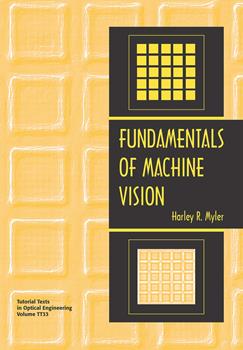|
Machine vision has many definition and is called by various names, often depending on the discipline that one practices. Computer vision, image understanding, scene analysis, and robot vision are some of the terms encountered. These terms are derived from computer science, signal processing, pattern recognition, and robotics studies, respectively. In this text, machine vision is explicitly defined as the study and implementation of systems that allow machines to recognize objects from acquired image data and perform useful tasks from that recognition. The term systems in this definition includes both hardware and software, with the restrictions that the hardware is constrained to acquisition and processing equipment and that the algorithms perform recognition and reasoning only. This eliminates issues of robots or vehicles, which are best left to other studies. The concept of a useful task helps confine the definition to a manageable level, yet be expandable to include large-scale general purpose vision systems.
Although intended as a supplement to a classroom short-course, the book stands alone as a useful self-study guide and is certainly usable as a primary text or supplement for a more extensive course offering. The organization is novel in that machine vision has essentially come of age and we may now view it (no pun intended) as an established and respected field of research and application with a strong theoretical foundation. Without foundation we simply cannot predict outcomes. Fortunately, it is now possible to engage in machine vision design with high probability of success. Because of this, the text takes the reader from fundamentals drawn from image processing and computer graphics to the methods of applied machine vision techniques. This back ground is then applied to the largely theoretical basis of human vision, which is, of course, the ultimate measure against which a machine vision system is compared.
There is a tendency for writers to feel that "more is better" and to burden a book with excessive coverage to the extent that the reader is overwhelmed. Since the literature on machine vision is so extensive, including a large number of texts, I have restricted the content to include only what is necessary to allow the reader to understand and construct machine vision systems that perform, once again, useful tasks based on the current state of the art. Additionally, I have prepared an Annotated Bibliography as an assist in navigating a sampling of this vast literature.
To fail to include open-ended discussion would expose the book to speedy decline with respect to a rapidly evolving area, so I have endeavored to leave some discussion without closure so as to stimulate new and creative work in this fascinating and dynamic field. As life-long learners we must strive to advance and grow, and it is my sincere hope that this book assists you in that process.
H.R. Myler
August 1998
|



